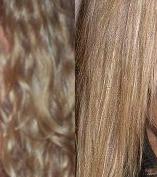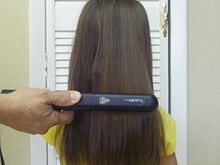Hair straightening: Difference between revisions
m Removed spam link |
m Added citation for info on Japanese hair straightening treatments |
||
| Line 1: | Line 1: | ||
[[File:Hairstraightenerrrrr.jpg|thumb|upright|Man with straightened hair]] |
[[File:Hairstraightenerrrrr.jpg|thumb|upright|Man with straightened hair]] |
||
'''Hair straightening''' is a hair styling technique used since the 1890s involving the flattening and straightening of hair in order to give it a smooth, streamlined, and 'sleek' appearance. It became very popular among black males and females of all races, during the 1950s, the former group because black men wanted to have the very popular and stylish "[[greaser (subculture)|greaser]]" look, either that or wearing Afros. It is accomplished using a [[hair iron]] or [[hot comb]], chemical [[relaxer]]s, Japanese hair straightening |
'''Hair straightening''' is a hair styling technique used since the 1890s involving the flattening and straightening of hair in order to give it a smooth, streamlined, and 'sleek' appearance. It became very popular among black males and females of all races, during the 1950s, the former group because black men wanted to have the very popular and stylish "[[greaser (subculture)|greaser]]" look, either that or wearing Afros. It is accomplished using a [[hair iron]] or [[hot comb]], chemical [[relaxer]]s, Japanese hair straightening,<ref>[http://beauty.about.com/od/curlyhair/fl/Japanese-Hair-Straightening-Treatments.htm Japanese Hair Straightening Facts]</ref> or [[Brazilian hair straightening]]. In addition, some [[shampoo]]s, [[Hair conditioner|conditioner]]s, and [[hair gel]]s can help to make hair temporarily straight. The process is often called "rebonding" in some countries from [[Southeast Asia]] (e.g. [[Singapore]], [[Malaysia]] and [[Philippines]]). The term "rebonding" was first used by REDS Hairdressing from Singapore in the late 1980s, which slowly spread to the rest of the region. <ref>[http://vanniedosa.wordpress.com/2008/08/23/facts-on-hair-rebonding/ Facts on Hair Rebonding]</ref> If done often, flat irons and chemicals can be damaging to hair. Excessive straightening often results in split ends. However, heat protectant sprays can decrease the damage. |
||
==Methods== |
==Methods== |
||
Revision as of 21:04, 30 October 2014

Hair straightening is a hair styling technique used since the 1890s involving the flattening and straightening of hair in order to give it a smooth, streamlined, and 'sleek' appearance. It became very popular among black males and females of all races, during the 1950s, the former group because black men wanted to have the very popular and stylish "greaser" look, either that or wearing Afros. It is accomplished using a hair iron or hot comb, chemical relaxers, Japanese hair straightening,[1] or Brazilian hair straightening. In addition, some shampoos, conditioners, and hair gels can help to make hair temporarily straight. The process is often called "rebonding" in some countries from Southeast Asia (e.g. Singapore, Malaysia and Philippines). The term "rebonding" was first used by REDS Hairdressing from Singapore in the late 1980s, which slowly spread to the rest of the region. [2] If done often, flat irons and chemicals can be damaging to hair. Excessive straightening often results in split ends. However, heat protectant sprays can decrease the damage.
Methods
Temporary


Hair irons and hot combs can only temporarily modify the shape/texture of hair. The straightened effect will be reversed by environmental factors, mainly contact with water from washing, rain, humidity, etc. This includes water in styling products such as gels applied after straightening, although careful use of such treatments can still produce usable results not much different from if the user had naturally straight hair before applying the product.
Permanent
Relaxers and the other methods permanently alter the structure of the hair, although new hair growth is not affected. The drug interferon alpha has been reported as being shown to modify hair follicles causing permanent change in a person's hair texture.[3]
Afro-textured hair

Hair straightening using a hot comb or relaxer has a long history among women and men of African American descent, reflected in the huge commercial success of the straightening comb popularized by Madam C. J. Walker in the early 1900s.[4] While the practice has at times been a controversial issue in discussions of racial identity, visits to the hair salon have become embedded in black culture, fulfilling an important social role especially for women.[5][6]
See also
References
- ^ Japanese Hair Straightening Facts
- ^ Facts on Hair Rebonding
- ^ Roger Highfield (2005-11-17). "Scientists hold out prospect of a pill to make your hair curl". www.telegraph.co.uk The Daily Telegraph. Retrieved 2009-01-08.
- ^ Noliwe M. Rooks (July 1996). Hair raising: beauty, culture, and African American women. Rutgers University Press. pp. 51ff. ISBN 978-0-8135-2312-5. Retrieved 8 November 2011.
- ^ bell hooks, "Straightening Our Hair", Z Magazine, September 1988
- ^ Noliwe M. Rooks (July 1996). Hair raising: beauty, culture, and African American women. Rutgers University Press. pp. 8–10. ISBN 978-0-8135-2312-5. Retrieved 8 November 2011.
External links
